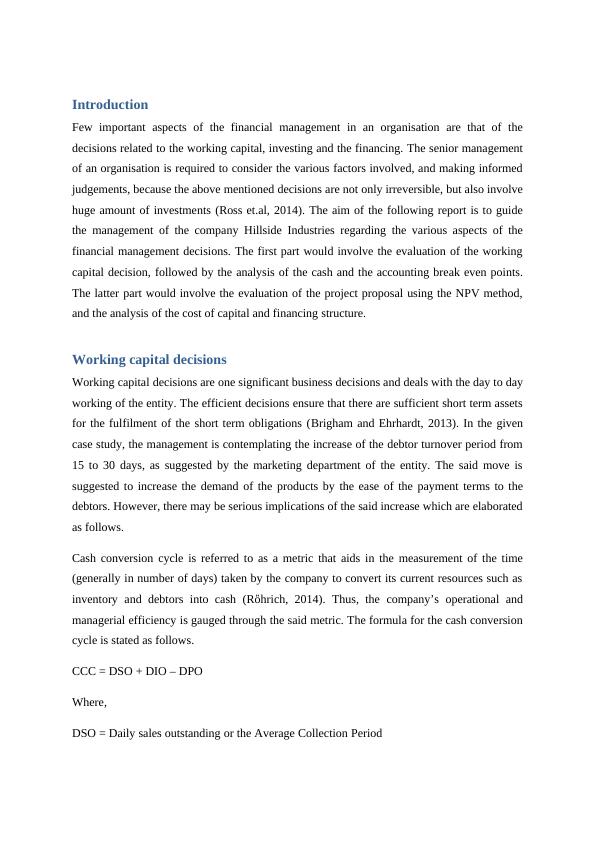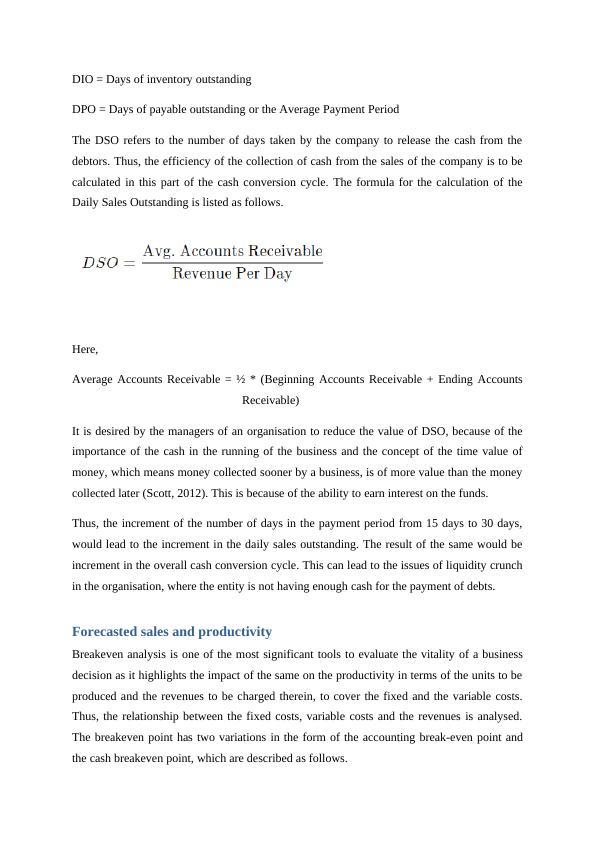A case study on the financial management of an organisation
Added on 2022-08-17
11 Pages2799 Words237 Views
FINANCIAL
MANAGEMENT
CASE STUDY REPORT
2/12/2020
STUDENT’S NAME:
MANAGEMENT
CASE STUDY REPORT
2/12/2020
STUDENT’S NAME:

Contents
Introduction............................................................................................................... 2
Working capital decisions............................................................................................. 2
Forecasted sales and productivity.................................................................................... 3
Evaluation of the project proposal.................................................................................... 4
Methods of financing and the resulting impacts...................................................................6
Conclusion................................................................................................................ 8
References................................................................................................................ 9
Introduction............................................................................................................... 2
Working capital decisions............................................................................................. 2
Forecasted sales and productivity.................................................................................... 3
Evaluation of the project proposal.................................................................................... 4
Methods of financing and the resulting impacts...................................................................6
Conclusion................................................................................................................ 8
References................................................................................................................ 9

Introduction
Few important aspects of the financial management in an organisation are that of the
decisions related to the working capital, investing and the financing. The senior management
of an organisation is required to consider the various factors involved, and making informed
judgements, because the above mentioned decisions are not only irreversible, but also involve
huge amount of investments (Ross et.al, 2014). The aim of the following report is to guide
the management of the company Hillside Industries regarding the various aspects of the
financial management decisions. The first part would involve the evaluation of the working
capital decision, followed by the analysis of the cash and the accounting break even points.
The latter part would involve the evaluation of the project proposal using the NPV method,
and the analysis of the cost of capital and financing structure.
Working capital decisions
Working capital decisions are one significant business decisions and deals with the day to day
working of the entity. The efficient decisions ensure that there are sufficient short term assets
for the fulfilment of the short term obligations (Brigham and Ehrhardt, 2013). In the given
case study, the management is contemplating the increase of the debtor turnover period from
15 to 30 days, as suggested by the marketing department of the entity. The said move is
suggested to increase the demand of the products by the ease of the payment terms to the
debtors. However, there may be serious implications of the said increase which are elaborated
as follows.
Cash conversion cycle is referred to as a metric that aids in the measurement of the time
(generally in number of days) taken by the company to convert its current resources such as
inventory and debtors into cash (Rὂhrich, 2014). Thus, the company’s operational and
managerial efficiency is gauged through the said metric. The formula for the cash conversion
cycle is stated as follows.
CCC = DSO + DIO – DPO
Where,
DSO = Daily sales outstanding or the Average Collection Period
Few important aspects of the financial management in an organisation are that of the
decisions related to the working capital, investing and the financing. The senior management
of an organisation is required to consider the various factors involved, and making informed
judgements, because the above mentioned decisions are not only irreversible, but also involve
huge amount of investments (Ross et.al, 2014). The aim of the following report is to guide
the management of the company Hillside Industries regarding the various aspects of the
financial management decisions. The first part would involve the evaluation of the working
capital decision, followed by the analysis of the cash and the accounting break even points.
The latter part would involve the evaluation of the project proposal using the NPV method,
and the analysis of the cost of capital and financing structure.
Working capital decisions
Working capital decisions are one significant business decisions and deals with the day to day
working of the entity. The efficient decisions ensure that there are sufficient short term assets
for the fulfilment of the short term obligations (Brigham and Ehrhardt, 2013). In the given
case study, the management is contemplating the increase of the debtor turnover period from
15 to 30 days, as suggested by the marketing department of the entity. The said move is
suggested to increase the demand of the products by the ease of the payment terms to the
debtors. However, there may be serious implications of the said increase which are elaborated
as follows.
Cash conversion cycle is referred to as a metric that aids in the measurement of the time
(generally in number of days) taken by the company to convert its current resources such as
inventory and debtors into cash (Rὂhrich, 2014). Thus, the company’s operational and
managerial efficiency is gauged through the said metric. The formula for the cash conversion
cycle is stated as follows.
CCC = DSO + DIO – DPO
Where,
DSO = Daily sales outstanding or the Average Collection Period

DIO = Days of inventory outstanding
DPO = Days of payable outstanding or the Average Payment Period
The DSO refers to the number of days taken by the company to release the cash from the
debtors. Thus, the efficiency of the collection of cash from the sales of the company is to be
calculated in this part of the cash conversion cycle. The formula for the calculation of the
Daily Sales Outstanding is listed as follows.
Here,
Average Accounts Receivable = ½ * (Beginning Accounts Receivable + Ending Accounts
Receivable)
It is desired by the managers of an organisation to reduce the value of DSO, because of the
importance of the cash in the running of the business and the concept of the time value of
money, which means money collected sooner by a business, is of more value than the money
collected later (Scott, 2012). This is because of the ability to earn interest on the funds.
Thus, the increment of the number of days in the payment period from 15 days to 30 days,
would lead to the increment in the daily sales outstanding. The result of the same would be
increment in the overall cash conversion cycle. This can lead to the issues of liquidity crunch
in the organisation, where the entity is not having enough cash for the payment of debts.
Forecasted sales and productivity
Breakeven analysis is one of the most significant tools to evaluate the vitality of a business
decision as it highlights the impact of the same on the productivity in terms of the units to be
produced and the revenues to be charged therein, to cover the fixed and the variable costs.
Thus, the relationship between the fixed costs, variable costs and the revenues is analysed.
The breakeven point has two variations in the form of the accounting break-even point and
the cash breakeven point, which are described as follows.
DPO = Days of payable outstanding or the Average Payment Period
The DSO refers to the number of days taken by the company to release the cash from the
debtors. Thus, the efficiency of the collection of cash from the sales of the company is to be
calculated in this part of the cash conversion cycle. The formula for the calculation of the
Daily Sales Outstanding is listed as follows.
Here,
Average Accounts Receivable = ½ * (Beginning Accounts Receivable + Ending Accounts
Receivable)
It is desired by the managers of an organisation to reduce the value of DSO, because of the
importance of the cash in the running of the business and the concept of the time value of
money, which means money collected sooner by a business, is of more value than the money
collected later (Scott, 2012). This is because of the ability to earn interest on the funds.
Thus, the increment of the number of days in the payment period from 15 days to 30 days,
would lead to the increment in the daily sales outstanding. The result of the same would be
increment in the overall cash conversion cycle. This can lead to the issues of liquidity crunch
in the organisation, where the entity is not having enough cash for the payment of debts.
Forecasted sales and productivity
Breakeven analysis is one of the most significant tools to evaluate the vitality of a business
decision as it highlights the impact of the same on the productivity in terms of the units to be
produced and the revenues to be charged therein, to cover the fixed and the variable costs.
Thus, the relationship between the fixed costs, variable costs and the revenues is analysed.
The breakeven point has two variations in the form of the accounting break-even point and
the cash breakeven point, which are described as follows.

End of preview
Want to access all the pages? Upload your documents or become a member.
Related Documents
Business Finance: Cash Conversion Cycle, NPV, IRR, Rights Issuelg...
|15
|2880
|44
Analysis of Working capital managementlg...
|9
|2114
|307
Cash Conversion Cycle Case Study 2022lg...
|7
|1230
|25
(solved) Assignment on Corporate Financelg...
|7
|1179
|295
Business Financelg...
|20
|3128
|106
Ratio Analysis | Financial Analysislg...
|9
|1270
|16
